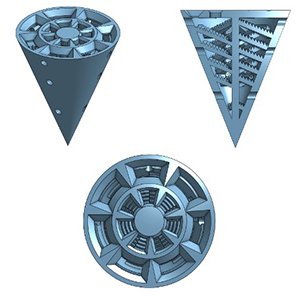3D-printed biological habitats for the protection and persistence of Rhizobia species in compacted soils

Published: 20 July 2022
Abstract Views: 1052
PDF: 293
Publisher's note
All claims expressed in this article are solely those of the authors and do not necessarily represent those of their affiliated organizations, or those of the publisher, the editors and the reviewers. Any product that may be evaluated in this article or claim that may be made by its manufacturer is not guaranteed or endorsed by the publisher.
All claims expressed in this article are solely those of the authors and do not necessarily represent those of their affiliated organizations, or those of the publisher, the editors and the reviewers. Any product that may be evaluated in this article or claim that may be made by its manufacturer is not guaranteed or endorsed by the publisher.
Similar Articles
- M. Cutini, C. Bisaglia, Procedure and layout for the development of a fatigue test on an agricultural implement by a four poster test bench , Journal of Agricultural Engineering: Vol. 44 No. s2 (2013): Proceedings of the 10th Conference of the Italian Society of Agricultural Engineering
- Ester Foppa Pedretti, Daniele Duca, Giuseppe Toscano, Giovanni Riva, Andrea Pizzi, Giorgio Rossini, Matteo Saltari, Chiara Mengarelli, Massimo Gardiman, Riccardo Flamini, Sustainability of grape-ethanol energy chain , Journal of Agricultural Engineering: Vol. 45 No. 3 (2014)
- Dario Friso, Lucia Bortolini, Influence of the trajectory angle and nozzle height from the ground on water distribution radial curve of a sprinkler , Journal of Agricultural Engineering: Vol. 43 No. 1 (2012)
- Alvaro Marucci, Adolfo Gusman, Barbara Pagniello, Andrea Cappuccini, Limits and prospects of photovoltaic covers in Mediterranean greenhouses , Journal of Agricultural Engineering: Vol. 44 No. 1 (2013)
- Damiano Coppolecchia, Davide Gardoni, Cecilia Baldini, Federica Borgonovo, Marcella Guarino, The influence on biogas production of three slurry-handling systems in dairy farms , Journal of Agricultural Engineering: Vol. 46 No. 1 (2015)
- Giulio Senes, Natalia Fumagalli, Paolo Stefano Ferrario, Daniele Gariboldi, Roberto Rovelli, Municipal community gardens in the metropolitan area of Milano. Assessment and planning criteria , Journal of Agricultural Engineering: Vol. 47 No. 2 (2016)
- Mohammad Bijankhan, Vito Ferro, Dimensional analysis and stage-discharge relationship for weirs: a review , Journal of Agricultural Engineering: Vol. 48 No. 1 (2017)
- Maria Lisa Clodoveo, Tiziana Dipalmo, Cristina Schiano, Domenico La Notte, Sandra Pati, What’s now, what’s new and what’s next in virgin olive oil elaboration systems? A perspective on current knowledge and future trends , Journal of Agricultural Engineering: Vol. 45 No. 2 (2014)
- Michela Zanetti, Benoît Brandelet, Diletta Marini, Andrea Sgarbossa, Chiara Giorio, Denis Badocco, Andrea Tapparo, Stefano Grigolato, Caroline Rogaume, Yann Rogaume, Raffaele Cavalli, Vineyard pruning residues pellets for use in domestic appliances: a quality assessment according to the EN ISO 17225 , Journal of Agricultural Engineering: Vol. 48 No. 2 (2017)
- Francesco Barreca, Pasquale Praticò, Giuseppe Davide Cardinali, A low-energy storage container for food and agriculture products , Journal of Agricultural Engineering: Vol. 52 No. 3 (2021)
<< < 18 19 20 21 22 23 24 25 26 27 > >>
You may also start an advanced similarity search for this article.

 https://doi.org/10.4081/jae.2022.1391
https://doi.org/10.4081/jae.2022.1391







